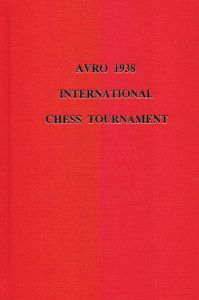Avro 1938 International Chess Tournament
Dale Brandreth, Robert Sherwood

Double round-robin Tournaments with a small group of elite players have always held a special place in chess history. One need only recall American events like New York 1924, Dallas 1958, and the two Piatigorsky Cups of 1963 and 1966 to recognize these events are often memorable. San Luis in 2005 and Morelia – Linares 2007 indicate that interest in this type of tournament is not waning.
Exactly why this is so is not completely clear but the competitiveness of the fields, where typically every player has a realistic chance to finish at or near the top, has to be one important factor. Another reason may be the democratic structure of the tournament. Unlike a Swiss where all the top contenders may not meet, they are guaranteed to in a round-robin. Unlike a round-robin in a double round-robin everyone gets exactly the same number of Whites and Blacks which can often as important as no players gets the extra White which can often make the difference between a good and exceptional finish.
One of the strongest tournaments using this format, perhaps only eclipsed by Las Palmas 1996, was that played in the Netherlands in the fall of 1938. The famous AVRO tournament, sponsored by the Dutch Broadcasting Company, Algemeene Vereeniging Radio Omroep, was (like San Luis and Morelia – Linares) an effort to provide a challenger to the then-reigning World Champion Alexander Alekhine. AVRO 1938 INTERNATIONAL CHESS TOURNAMENT by Robert Sherwood and Dale Brandreth fills a major hole in chess literature as it is the first proper English language tournament book for this historic event.
Each of the eight players competing in this double round-robin were giants. All of them were either present or future World Champions (Capablanca, Alekhine, Euwe, and Botvinnik), or considered challengers for the throne (Keres, Fine, Reshevsky, and Flohr). Many of the 56 games from AVRO are still remembered today with several considered immortal (remember Botvinniks 30.Ba3! against Capablanca?). Sherwood and Brandreth present all the games from the event with deep annotations, but that is not all they offer. There are contemporary reports from Dutch newspapers of the time which have been translated into English and offer a feel for the tournament in real time. They give a sense of the fast moving tempo of the event which had only a few free days with the players constantly moving from city to city to play the next round.
The fatigue generated by this scheduling may have had an impact on the play of the two oldest players (Capablanca at 50 and Alekhine at 46). As it was, AVRO 1938 will be remembered in part as an event where youth was served since the youngest (Keres at 22) and second youngest (Fine at 24) tied for first. This event was supposed to be a qualifier for a World Championship match with Alekhine but neither winner would ever play directly for the throne. Both youngsters are remembered for their rocket starts (Fine with 5.5 from 6! and Keres 5 from 7) but thanks to the handy round-by-round scoretable on page xxxvii it is easy to see just how streaky AVRO was. The 26-year-old Sammy Reshevsky started with 1 from 5 and Max Euwe with 2 from 7. Both rallied to finish at 50 percent.
Besides the games with annotations (sometimes 6 pages to a game), tournaments reports of the time and crosstables, AVRO 1938 INTERNATIONAL CHESS TOURNAMENT also features many historic photos, several articles by Dale Brandreth putting AVRO 1938 into context, recent games by the AVRO competitors in the two years preceding the event and various indices. This a sturdily bound and attractively produced work.
AVRO 1938 INTERNATIONAL CHESS TOURNAMENT is a classic tournament book that deserves a home in all chess lovers libraries.
